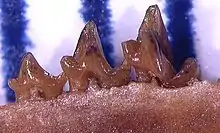Batodonoides
Batodonoides (often misspelled as Batonoides) is a genus of extinct shrew-like mammals, which includes a species that is possibly the smallest mammal to have ever lived. Species of Batodonoides lived about 42 to 53 million years ago during the early to middle Eocene Epoch in North America. The genus contains four species: the type species B. powayensis, the older B. vanhouteni,[2] B. walshi[3] and B. rileyi.[4]
| Batodonoides Temporal range: Eocene, | |
|---|---|
 | |
| Teeth | |
| Scientific classification | |
| Kingdom: | |
| Phylum: | |
| Class: | |
| Order: | |
| Family: | |
| Genus: | †Batodonoides |
| Species | |
Species
B. powayensis
B. powayensis is based on the type specimen UCMP V-96459, and was a ground dwelling insectivore.[5] This species is younger than its counterpart, B. vanhouteni, existing between approximately 46.2 to 42 million years ago. It is based on fossilised remains recovered from California, USA.[1]
B. vanhouteni
Based on the size of its molar teeth, it is estimated that Batodonoides vanhouteni may have weighed only 0.93-1.82 grams (with 1.3 g most likely). The species lived about 53 million years ago during the early Eocene Epoch in North America.[2]
B. vanhouteni, described in 1998 by Bloch and colleagues, is the oldest species, and was discovered in Wasatchian deposits in Wyoming, USA.[1] It is based on a juvenile specimen, consisting of a mandible and some teeth.[2]
References
- Batodonoides at the Paleobiology Database
- Bloch, Jonathan I.; Rose, Kenneth D.; Gingerich, Philip D. (1998). "New Species of Batodonoides (Lipotyphla, Geolabididae) from the Early Eocene of Wyoming: Smallest Known Mammal?". Journal of Mammalogy. 79 (3): 804–827. doi:10.2307/1383090. JSTOR 1383090.
- Kelly, Thomas S. (2010). "New records of Marsupialia, Lipotyphla, and Primates from the Duchesnean (middle Eocene) Simi Valley Landfill local fauna, Sespe Formation, California" (PDF). Paludicola. 7 (4): 158–169. Archived from the original (PDF) on 2013-12-30. Retrieved 2013-12-30.
- Thomas S. Kelly (2013). "New records of small mammals from the latest Uintan (middle Eocene) Strathern local fauna, Sespe Formation, California". Paludicola. 9 (2): 56–69.
- Novacek, M. J. (1976). "Insectivora and Proteutheria of the late Eocene (Uintan) of San Diego County, California" (PDF). Natural History Museum of Los Angeles County Contributions in Science (283): 1–51. Archived from the original (PDF) on 2013-12-31. Retrieved 2013-12-30.